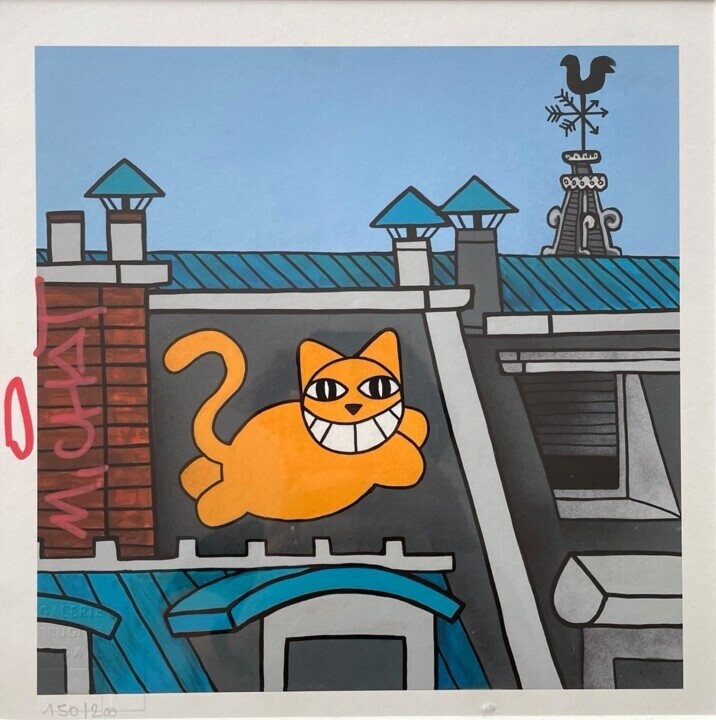 M. CHAT en cours de création - Paris 4ème, author: LoveBoat, via Wikipedia
M. CHAT en cours de création - Paris 4ème, author: LoveBoat, via Wikipedia
M. Chat
M. Chat, also known as Monsieur Chat, is a contemporary French street artist renowned for his iconic yellow grinning cat. The character first appeared in the early 2000s on walls and rooftops across Paris and quickly became a symbol of joy and positivity in urban spaces.
The yellow cartoon cat is characterized by its large Cheshire Cat grin and body. The cat is most often portrayed in a running pose, but has also been variously depicted waving signal flags, bouncing on a ball, sporting angel wings, and waving in greeting at the entrance to a train station. It is sometimes accompanied by the tag "M. Chat" in small letters.
 M. Chat sur Authentique Stock Certificate Playboy (2021). Painting, Marker / Pencil on Paper
M. Chat sur Authentique Stock Certificate Playboy (2021). Painting, Marker / Pencil on Paper
The identity of M. Chat remained a mystery for many years, adding to the allure of his work. However, it was later revealed that the artist behind the character is Thoma Vuille, a Franco-Swiss artist. Vuille started the M. Chat project as part of a larger initiative to make art accessible to everyone and to spread happiness in everyday life. His works have since expanded beyond the streets of Paris, with the grinning cat appearing in cities around the world, from New York to Tokyo.
During a 2010 exhibition in Paris, Vuille reported having 60 cats across the city. Currently, there are two in New York City, one on the High Line at 28th Street and another that was on the SE Corner of 27th and 8th Avenue by the FIT Museum but has since been covered by other graffiti. In Stamford, Vermont, there is one in a barn. Three are in Pristina, Kosovo, located in the central pedestrian area, including one on the side of the National Theatre. Additionally, there are several in Vietnam, Naples, Sarajevo (Bosnia and Herzegovina), and Belgrade (Serbia). There is also one in Seoul, South Korea, and one in Tangier, Morocco.
M. Chat's art has transcended its origins in street art to enter galleries and exhibitions, while still maintaining its roots in public spaces. His work is celebrated for its ability to connect with people of all ages and backgrounds, turning the simple image of a cat into a powerful symbol of optimism and unity.
 M. Chat Île de la cité (2022). Screenprinting on Paper
M. Chat Île de la cité (2022). Screenprinting on Paper
The evolution of Thoma Vuille into M. Chat
Thoma Vuille's journey into the world of street art began at the age of 15, driven by a desire to honor the memory of his grandfather, who was a house painter. His early experiments with acrylic paint on the streets laid the foundation for what would become a defining career. After earning a professional baccalaureate in civil engineering, Vuille pursued further education at the Institut d'arts visuels d'Orléans (now the École Supérieure d'Art et de Design d'Orléans) from 1995 to 2001. It was during this period that he created his most iconic work—the M. Chat series, featuring a yellow-orange cat with a broad, infectious smile, often painted on city walls.
The inspiration for M. Chat came in 1997 during a workshop with children at a school in Orléans, where a little girl's drawing of a cat sparked Vuille's imagination. He began painting his version of the cat on the walls and rooftops of Orléans, aiming to infuse the gray cityscape with a touch of humanity and warmth. Vuille's goal was simple: to spread joy and optimism through his art. He initially signed his works with the enigmatic name "Mr. Chat," creating the illusion of a collective behind the creations, leaving the identity of the artist a mystery.
As M. Chat's popularity grew, Vuille's work expanded beyond Orléans to other cities in France and abroad, including Paris, London, Vienna, Geneva, and New York. In 2004, the character gained further recognition when it appeared on the esplanade of the Centre Pompidou in Chris Marker's TV film Chats perchés. Subsequent high-profile appearances, such as on a Sarajevo tramway in 2005 and during a New York demonstration in 2006, solidified M. Chat's status as an international street art icon.
However, Vuille's clandestine activities came to an abrupt halt on March 18, 2007, when he was caught by municipal police while painting a wall in Orléans. Forced to reveal his identity, Vuille was fined a symbolic €300. Following this, he transitioned from being an underground graffiti artist to collaborating with institutions such as the city of Orléans and the Poitou-Charentes Regional Council. While some critics saw this as a betrayal of his street art roots, Vuille defended his evolution, arguing that his art had matured and that he sought to earn a living from his work after years of financial struggle.
Vuille's work with M. Chat continued to evolve, characterized by a constant variation of the cat's figure. The simple, clear lines of the smiling yellow cat gave it the appearance of a logo, yet it retained a deeper symbolic dimension. The cat's image, which originated from street art, was versatile, capable of taking on various forms—whether from the front or side, with or without wings, alone or accompanied. Despite its simplicity, M. Chat had a strong, adaptable identity that resonated with a wide audience.
The smile of M. Chat, which was present in the original drawing that inspired Vuille, played a significant role in the widespread appeal of his work. This smile, akin to the enigmatic grin of Lewis Carroll's Cheshire Cat, contributed to the universal and poetic nature of Vuille's art. As his work expanded beyond street painting, it took on new dimensions, with performances that moved away from the individualistic world of graffiti and sought to engage with communities, fostering a culture of proximity and shared art.
Through M. Chat, Thoma Vuille has created a lasting symbol of joy and optimism, transforming urban landscapes around the world with his simple yet profound art.


 Selena Mattei
Selena Mattei


